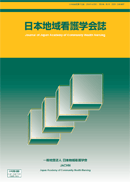Volume 21, Issue 2
Displaying 1-8 of 8 articles from this issue
- |<
- <
- 1
- >
- >|
Original Articles
-
2018 Volume 21 Issue 2 Pages 4-13
Published: 2018
Released on J-STAGE: August 20, 2019
Download PDF (1091K) -
Mothers’ Process of Avoiding Radiation Exposure by Fukushima Daiichi Nuclear Power Stations Accident2018 Volume 21 Issue 2 Pages 14-21
Published: 2018
Released on J-STAGE: August 20, 2019
Download PDF (1069K)
Research Reports
-
2018 Volume 21 Issue 2 Pages 22-30
Published: 2018
Released on J-STAGE: August 20, 2019
Download PDF (1109K) -
2018 Volume 21 Issue 2 Pages 31-39
Published: 2018
Released on J-STAGE: August 20, 2019
Download PDF (1104K) -
2018 Volume 21 Issue 2 Pages 40-48
Published: 2018
Released on J-STAGE: August 20, 2019
Download PDF (1084K) -
2018 Volume 21 Issue 2 Pages 49-57
Published: 2018
Released on J-STAGE: August 20, 2019
Download PDF (1115K)
Informations
-
2018 Volume 21 Issue 2 Pages 58-64
Published: 2018
Released on J-STAGE: August 20, 2019
Download PDF (1020K) -
2018 Volume 21 Issue 2 Pages 65-74
Published: 2018
Released on J-STAGE: August 20, 2019
Download PDF (1085K)
- |<
- <
- 1
- >
- >|
